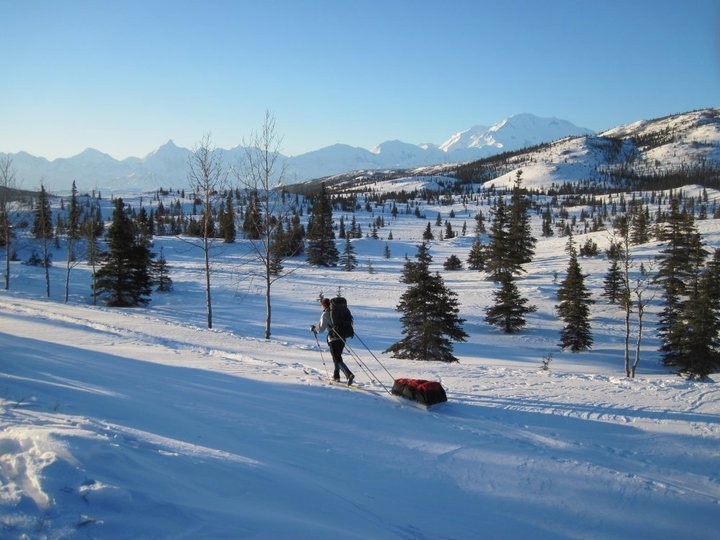Ah, March. A nice blend of winter and spring here in Alaska’s interior. For the past few weeks we’ve had a high pressure system, blown in from Siberia, leaving clear, clear weather. The odd thing about the bluebird days and moonlit nights is that for us, clear=cold. Without an insulating “blanket” of clouds above our heads, any semblance of warmth quickly dissipates. So although the sun is now high enough on our horizon to warm the days to 20F, the nights easily drop to -20 or -30F. (Don’t worry, you’re likely considering visiting Denali in the summer, when such extremes don’t happen!).
With sunshine in our heads, two friends and I, including fellow Camp Denali and North Face Lodge naturalist guide Andrew McCarthy, decided to embark on a winter adventure in the park. We would ski from Wonder Lake, near the end of the park road, to headquarters, at the entrance. We loaded up our trusty polk (a sled designed to be pulled behind a skier), named Virgil, with food for a week, packed our skis, a tent, down sleeping bags, and various other camping items.
Simon Hamm, an owner of Camp Denali, graciously offered to fly us to our start point. Simon and his wife Jenna had skied this same route about a decade earlier, and we hoped to roughly follow their route and schedule. We spent our first night at Camp Denali, a virtual ghost town in winter’s shadows, but cozy for four travelers and with quite a view to boot! From there we skied across Wonder Lake and began henceforth to follow the route of the park dog team. Denali is unique in that no vehicles, including snowmachines, are allowed in the park in winter (generally October until May). Instead, the park is patrolled by up to three teams of dogs from the Denali kennels.
Winter camping, for those not initiated, is quite a feat. Unlike the willow ptarmigan with their layers of feathery down or caribou with their hollow insulating guard hairs and countercurrent heat circulation in their legs, we need lots and lots of gear to keep us warm. Down is the winter insulator of choice, and we used down sleeping bags, down jackets, down mittens, down boots and even down pants. Each of us ate meals designed to feed three people. Skiing and cold are a great way to burn calories! Getting camp set up and taken down was a 2-3 hour process, mainly involving packing snow for a suitable campsite and melting lots of snow to give us our water and meals.
We skied along the McKinley Bar Trail and upstream on the McKinley River (an impassable obstacle in the summers). Our first campsite was near the Muldrow Glacier, a popular hiking destination for our naturalist guided hikes in the summer. Along our trip we were constantly gawking at locations we knew so well in the summer now cloaked in snow. Suddenly getting to that large glacial erratic boulder, normally so difficult to reach due to rivers or lakes, was now easy to ski up to. It’s no wonder Native Alaskan Athabaskan peoples talk about winter as the best time of year to travel!
We spent four more nights on the trail, enjoying views of Denali, dall sheep rams at Polychrome, fiery aurora borealis shows at night, a curious fox around our tent, and dozens of sets of wolf, lynx, and even wolverine tracks. We spent hours scrambling over the frozen overflow ice on the rivers, and did battle with the long hauls up the passes. Overall, this park continues to amaze me. No matter how many times I strike off across the tundra, on foot, skis or by vehicle, I find something new and eye opening at my feet and around me. That is the mystery and lore of Denali, and oh, am I excited for summer!




